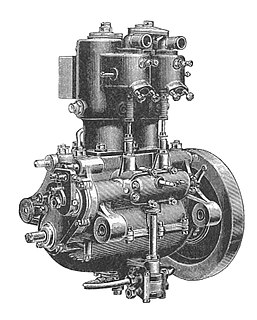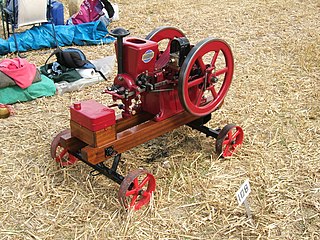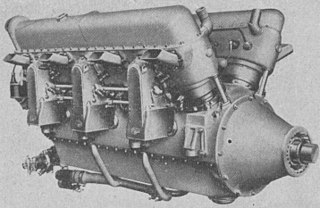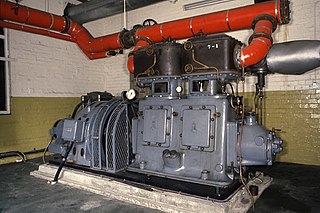
The Monosoupape, was a rotary engine design first introduced in 1913 by Gnome Engine Company. It used a clever arrangement of internal transfer ports and a single pushrod-operated exhaust valve to replace the many moving parts found on more conventional rotary engines, and made the Monosoupape engines some of the most reliable of the era. British aircraft designer Thomas Sopwith described the Monosoupape as "one of the greatest single advances in aviation".

A crankcase is the housing for the crankshaft in a reciprocating internal combustion engine. In most modern engines, the crankcase is integrated into the engine block.

A hit-and-miss engine or Hit 'N' Miss is a type of internal combustion engine that is controlled by a governor to only fire at a set speed. They are usually 4-stroke but 2-stroke versions were made. It was conceived in the late 19th century and produced by various companies from the 1890s through approximately the 1940s. The name comes from the speed control on these engines: they fire ("hit") only when operating at or below a set speed, and cycle without firing ("miss") when they exceed their set speed. This is as compared to the "throttle governed" method of speed control. The sound made when the engine is running without a load is a distinctive "Snort POP whoosh whoosh whoosh whoosh snort POP" as the engine fires and then coasts until the speed decreases and it fires again to maintain its average speed. The snorting is caused by atmospheric intake valve used on many of these engines.
The following outline is provided as an overview of and topical guide to automobiles:

The Austin 10 hp is a small car produced between 1910 and 1915 by the British car manufacturer Austin at their Longbridge, Worcestershire plant near Birmingham. 1,336 cars were made, 213 with the 1125 cc engine and 1,123 with the 1615 cc engine. Like the 1087 cc Austin 7 hp produced by both Austin and Du Cros's Swift Motor Company it was not very successful when sold with the small engine.

The oil pump in an internal combustion engine circulates engine oil under pressure to the rotating bearings, the sliding pistons and the camshaft of the engine. This lubricates the bearings, allows the use of higher-capacity fluid bearings and also assists in cooling the engine.
The 1913 20-cylinder Anzani air-cooled radial engine was the first four row radial and one of the most powerful engines of its period, though few were used.

The Green D.4 was a four-cylinder watercooled inline piston engine produced by the Green Engine Co in the UK in 1909. It produced about 60 hp (45 kW) and played an important role in the development of British aviation before World War I.

The Lorraine 12H Pétrel was a French V-12 supercharged, geared piston aeroengine initially rated at 370 kW (500 hp), but later developed to give 640 kW (860 hp). It powered a variety of mostly French aircraft in the mid-1930s, several on an experimental basis.

High-speed steam engines were one of the final developments of the stationary steam engine. They ran at a high speed, of several hundred rpm, which was needed by tasks such as electricity generation.
The Austin 15-20 is the smaller-engined of the almost identical pair of new cars announced by Herbert Austin in February 1906. A very complete catalogue with detailed specifications was issued at the same time. As well as the engine's smaller bore the 15-20 differed from the 25-30 by being only available with a live rear axle and not chain-drive. Otherwise the specifications were the same, the very minor differences are detailed below.

The Vauxhall 20-60 is a four or five-seater saloon, limousine, tourer or coupé-cabriolet manufactured by Vauxhall of Luton. It was announced on 28 September 1927 with a six-cylinder engine and a four-speed gearbox. A cautious move downmarket. "The first time any six-cylinder Vauxhall has been sold under £1000!" "British & Vauxhall". The initial 2.7-litre engine was enlarged to 3-litres after twelve months.
The Potez 8D is the largest member of the Potez D series of air-cooled piston aircraft engines which share several common features. It is a supercharged eight cylinder inverted engine with a take-off power of 373 kW (500 hp).

Their new Daimler 22 horsepower full-size luxury car was first displayed by Daimler in April 1902 at The Automobile Club’s Exhibition in London's Agricultural Hall. Daimler had elected to drop their multiple old low powered designs and restrict themselves to this 22 horsepower and a pair of 9 or 12 horsepower cars to the same design as the 22 but more lightly constructed. The King’s not quite finished new Daimler 22 was reported to be the chief attraction of the show.

The 4 VD 14,5/12-1 SRW is an inline four-cylinder diesel engine produced by the VEB IFA Motorenwerke Nordhausen from 1967 to 1990. The engine was one of the standard modular engines for agricultural and industrial use in the Comecon-countries. Approximately one million units were made.

The Mercedes-Benz OM 138 is a diesel engine manufactured by Daimler-Benz. In total, 5,719 units were produced between 1935 and 1940. It was the first diesel engine especially developed and made for a passenger car. The first vehicle powered by the OM 138 was the Mercedes-Benz W 138. The light Mercedes-Benz trucks L 1100 and L 1500 as well as the bus O 1500 were also offered with the OM 138 as an alternative to the standard Otto engine.



















